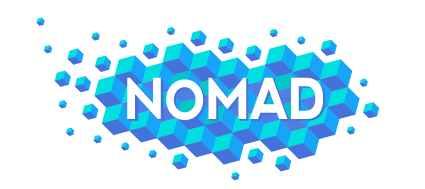Kristian Thygesen
Using automated computational workflows to find better materials for photo-catalytic water splitting
Moritz to Baben
NOMAD-inspired developments at GTT-Technologies
Besides the direct implications in terms of materials data, the method developments in the NOMAD CoE also have implications on other communities such as the Calphad community. In this presentation, two projects are introduced: In the project "SoftMadeHart", GTT-Technologies has screened millions of compositions in a 12-component chemical space to identify cheap but sustainable hardfacing alloys for mining applications. The target properties include both properties important for the application and also for the processing of the coating materials. Preliminary experimental tests have confirmed the predicted properties (phases formed, liquidus/solidus temperature, Martensite start temperature), despite the fact that the compositions are rather far away from the optimized compositions. As an outlook, the transfer project T01 of the recently extended collaborative research center SFB 1394 "Structural and Chemical Atomic Complexity — From Defect Phase Diagrams to Material Properties" will be introduced. In that project, workflows to automate data transfer from experimental and atomistic simulations to Calphad assessments of defect phases will be generated
Piero Altoe
Accelerate time-to-science with NVIDIA: from the superchip to full application
Due to the AI revolution, the technology updates in the computing space are accelerating. Researchers and developers need the best possible support from the industry players to embrace the changes and modernize the applications. NVIDIA, for more than a decade, is investing in hardware and software to create a full stack platform, which provides the highest possible performance together with a richness of programming languages and libraries. Here I’ll present the new NVIDIA GH200 chip, and the new approaches to application porting, including standard languages. The last, but most important, part will be dedicated to a review of the AI ecosystem in material science and the current challenges
Luca Ghiringhelli
Bridging scales in materials modeling with Occam-shaved machine learning
The modeling of macroscopic properties of materials often require the accurately evaluation of physical quantities at several time and length scales. Here we show how symbolic inference, i.e., the machine learning of simple analytical expressions that explain and generalize the available the data, can effectively bridge physical scales. The focus is on learning models that are as simple as possible (but not simpler...), with as few as possible data points. We demonstrate the application of the methods to the modeling of catalytic properties of materials [1,2,3,4] and thermal conductivity [5].
[1] Foppa, L., Ghiringhelli, L.M., et al., 2021. Materials genes of heterogeneous catalysis from clean experiments and artificial intelligence. MRS bulletin, pp.1-11.
[2] Foppa, L., Sutton, C., Ghiringhelli, L.M., De, S., Löser, P., Schunk, S.A., Schäfer, A. and Scheffler, M., 2022. Learning design rules for selective oxidation catalysts from high-throughput experimentation and artificial intelligence. ACS catalysis, 12(4), pp.2223-2232.
[3] Foppa, L. and Ghiringhelli, L.M., 2022. Identifying outstanding transition-metal-alloy heterogeneous catalysts for the oxygen reduction and evolution reactions via subgroup discovery. Topics in Catalysis, 65(1-4), pp.196-206.
[4] Mazheika, A., Wang, Y.G., Valero, R., Viñes, F., Illas, F., Ghiringhelli, L.M., Levchenko, S.V. and Scheffler, M., 2022. Artificial-intelligence-driven discovery of catalyst genes with application to CO2 activation on semiconductor oxides. Nature Communications, 13(1), p.419.
[5] Purcell, T., Scheffler, M., Ghiringhelli, L.M. and Carbogno, C., 2023. Accelerating materials-space exploration for thermal insulators by mapping materials properties via artificial intelligence. npj Comput Mater 9, 112 (2023). https://doi.org/10.1038/s41524-023-01063-
James Kermode
Scientific Machine Learning Enhanced Materials Modelling at the Atomistic and Electronic Structure Scales
Scientific machine learning (SciML) combines the positive features of mechanistic and data-driven approaches. I will describe recent work to leverage its advantages to construct efficient surrogates for electronic structure models [1] and at the interatomic potential level [2]. The latter benefits from recent work carried out within the NOMAD Centre for Excellence to massively parallelise the Gaussian approximation potential fitting process [3]. I will also discuss the importance of robust uncertainty estimates when using surrogate models and report recent efforts in this direction. The talk will be illustrated with ongoing industrially relevant applications, e.g. dislocations in tungsten [4] and austenitic stainless steels [5] subject to radiation damage.
[1] L. Zhang et al., npj Comput. Mater. 8 158 (2022)
[2] J. P. Darby, J. R. Kermode, and G. Csányi, Compressing Local Atomic Neighbourhood Descriptors, Npj Computational Materials 8, 166 (2022).
[3] S. Klawohn, J. R. Kermode and A. P. Bartók, Mach. Learn. Sci. Tech. 4, 015020 (2023)
[4] P. Grigorev, A. M. Goryaeva, M.-C. Marinica, J. R. Kermode, and T. D. Swinburne, Acta Mater. 247 118734 (2023)
[5] L. Shenoy, C. D. Woodgate, J. B. Staunton, A. P. Bartók, C. S. Becquart, C. Domain, and J. R. Kermode arXiv:2309.08689 (2023)
